drtbear1967
Musclechemistry Board Certified Member
for fat loss; what’s best for improving overall health; is there such a thing as an all-you-can-eat peanut butter diet; are total calories or food quality more important.
Eating healthy is complicated.
Not really. Eating healthy seems complicated because of the abundance of information on food, weight loss, disease prevention and what you should and shouldn’t eat to look better naked. It’s no wonder people are frustrated and discouraged because they’ve tried popular diets that promised to be the diet for effortless fat loss: low fat, low carb, vegetarian, intermittent fasting, ketogenic, and all the rest.
The Basics are Not Replaceable
It’s not uncommon for someone to read the information below and scoff that it’s “too simple.” They want more than the basics. They think a diet that emulates their favorite Instagram fit-pro’s habits will yield better results. They think they’re above the basics.
The problem, however, is that most people have not even mastered the basics. Complex, restrictive diets that eliminate foods or food groups don’t produce better, lasting results — they just reduce calorie intake. People falsely think they’re more effective because of their complexity. These unnecessarily obsessive, restrictive diets can lead to things you don’t want like binge eating, negative body image, or incessant yo-yo dieting.
Complex or complicated does not mean better. Don’t delude yourself into thinking you need something more advanced if you don’t apply the information shared here for months at a time.
Do You Want a Diet or a Lifestyle?
Most diets have a timeframe. You follow it for 12-16 weeks (or until your willpower bleeds dry) and then you’re done and go back to eating whatever was normal pre-diet, or worse because you can’t stop eating all the stuff that was banned from the diet. Sound familiar?
Someone who will stand on stage in a bikini to be judged will follow a diet that meticulously tracks calories to reach ultra-low levels of body fat that’s meant to be sustained for a short period of time (people often forget this part and think it’s easy, or healthy, to have very low body fat levels long term). Problems arise when the average person who just wants to feel great and look better naked attempts to mimic those diets.
Most people need to create a sustainable lifestyle built upon simple habits that can be maintained long term. Not for 12-16 weeks, but for 12-16 months and beyond. A major distinction between a diet and lifestyle: quick-fix diets instill a perfection mindset (never missing a meal, hitting the exact calorie target every day, never “cheating,” you go all in); a healthy-eating lifestyle is about consistency, not perfection, so there’s no burden or stress of thinking you need to be perfect day in, day out — it is not an “all or nothing” game.
Rigid diets that create a perfection-obsessed mindset around food can drown you in their monstrous wake of negative body image and disordered eating habits.
You Must Find Pleasure in the Process
You can only force yourself to follow a style of eating you hate, or that dominates your life, for so long. Eventually you’ll say Screw it! and throw your hands in the air as a declaration of frustration and signaling the end of the diet’s lifespan.
Many people mistakenly look at eating healthy as being torturous, bland, boring, difficult. Establishing better eating habits may be difficult in the beginning, depending on your current food habits, but you must focus on the pleasure that accompanies the process. The pleasure of nourishing your body; properly fueling and recovering from workouts; forging new habits that serve you; actively investing in your health; proving to yourself you can establish rewarding, positive habits.
If you get frustrated from trying to find vegetables or lean-protein sources you enjoy, or have trouble hitting the 80% whole-food target discussed below, refocus on the pleasures you should be reaping from this lifestyle change.
Does It Have to be about Fat Loss?
Tips for weight loss are laced throughout this article, because many people want to lose fat. If you’re burned out on constantly thinking about fat loss, watching what you eat, or otherwise being on a never-ending journey of trying to whittle down to a smaller size, don’t think about fat loss.
If your brain is begging for a break from basing every food choice on losing body fat, choose other reasons for changing your eating habits. Choose to adjust your eating choices to:
How to Eat Healthy
Whatever your why may be for wanting to eat healthy, here are the foods that should make up most of your eating choices.
Eat These Foods Most of The Time
The common thread connecting these foods — they’re minimally processed whole foods. Why have these foods been chosen? Because eating mostly nutrient-dense whole foods, including lots of plant-based foods, has been shown to be most important for improving health and warding off disease.
The following images and examples are not exhaustive, and many could fall in other categories. Eggs, for example, could be listed in the fat and protein groups but appear under fats; corn is a grain when eaten as popcorn but considered a starchy vegetable when consumed as corn on the cob. Don’t get obsessed with minor details but use this as a guide for building meals and snacks.
Fats
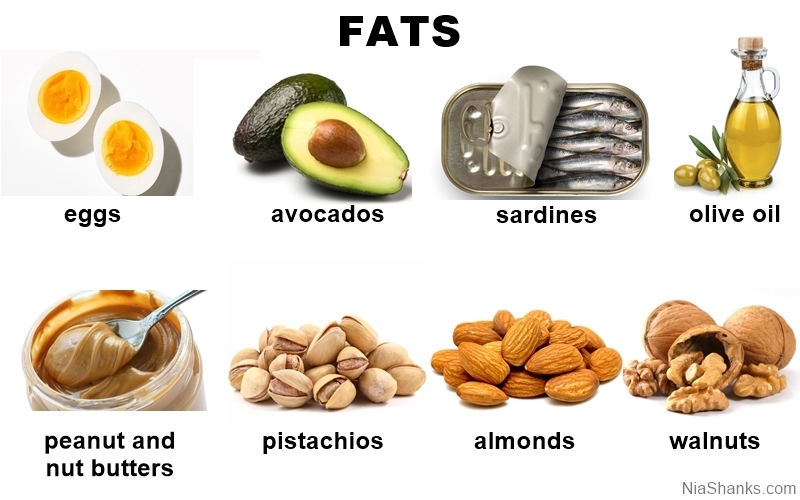 These whole-food sources are packed with healthy fats. Other examples not shown include fatty fish like salmon and mackerel; plant sources include flax seeds, olives, chia seeds.
These whole-food sources are packed with healthy fats. Other examples not shown include fatty fish like salmon and mackerel; plant sources include flax seeds, olives, chia seeds.
Protein
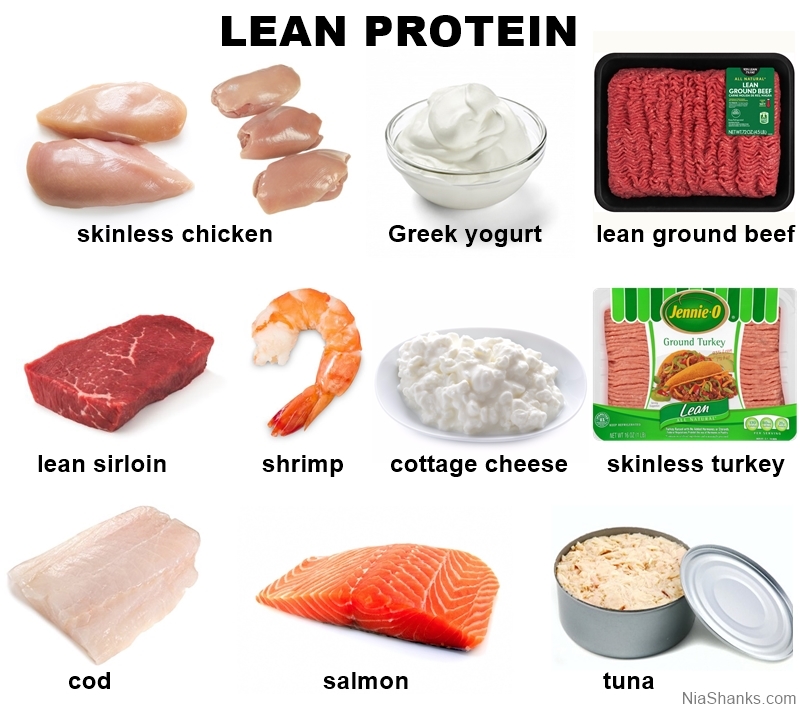 Notice that lean sources of protein are shown. Fattier cuts of meat and dairy are fine but shouldn’t make up the bulk of your protein choices.
Notice that lean sources of protein are shown. Fattier cuts of meat and dairy are fine but shouldn’t make up the bulk of your protein choices.
Starchy Vegetables
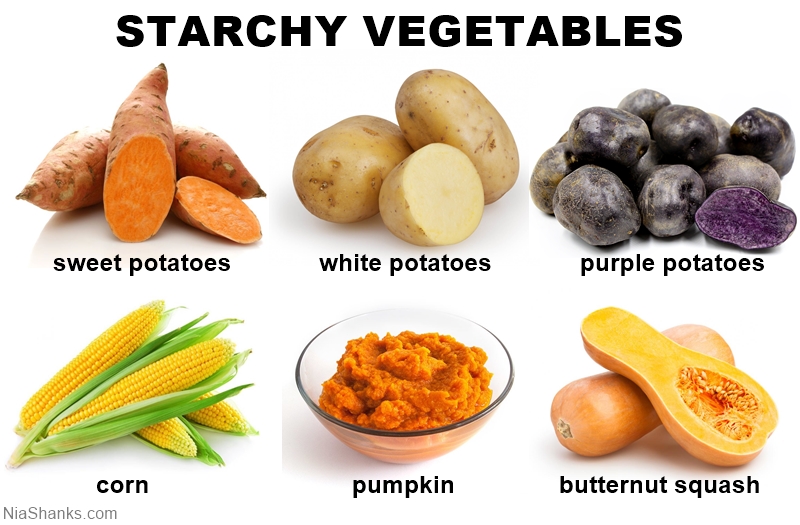
Non-Starchy Vegetables
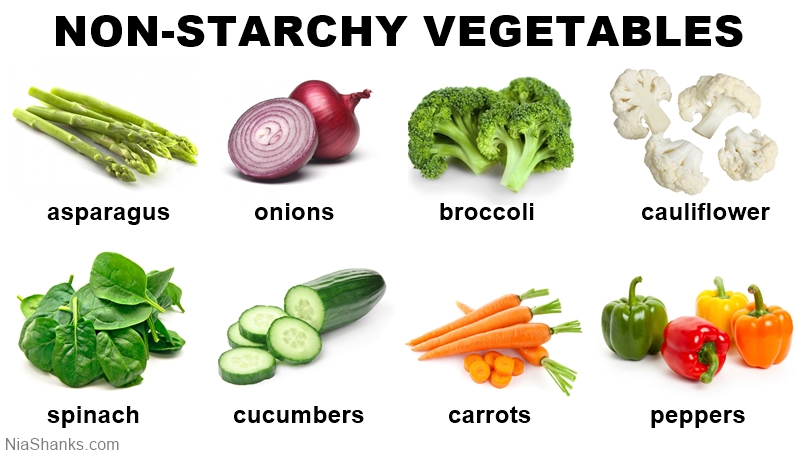 Why two vegetable categories? Because some people rely too much on the starchy vegetables and eat nothing but potatoes. Potatoes are healthy and satiating, but don’t neglect non-starchy veggies. A good rule of thumb is to “eat the rainbow” as often as possible so you get tons of nutrients in a fiber-packed package. Non-starchy veggies are a great way to increase satiety because they take up a lot of space in the stomach without packing a lot of calories (i.e., they’re high-volume, low-calorie foods).
Why two vegetable categories? Because some people rely too much on the starchy vegetables and eat nothing but potatoes. Potatoes are healthy and satiating, but don’t neglect non-starchy veggies. A good rule of thumb is to “eat the rainbow” as often as possible so you get tons of nutrients in a fiber-packed package. Non-starchy veggies are a great way to increase satiety because they take up a lot of space in the stomach without packing a lot of calories (i.e., they’re high-volume, low-calorie foods).
Bake them, sauté them, grill them, steam them, eat them raw, turn them into noodles and use in place of traditional pasta, blend them in smoothies. Doesn’t matter how you get them in your belly, just eat them.
Beans and Legumes
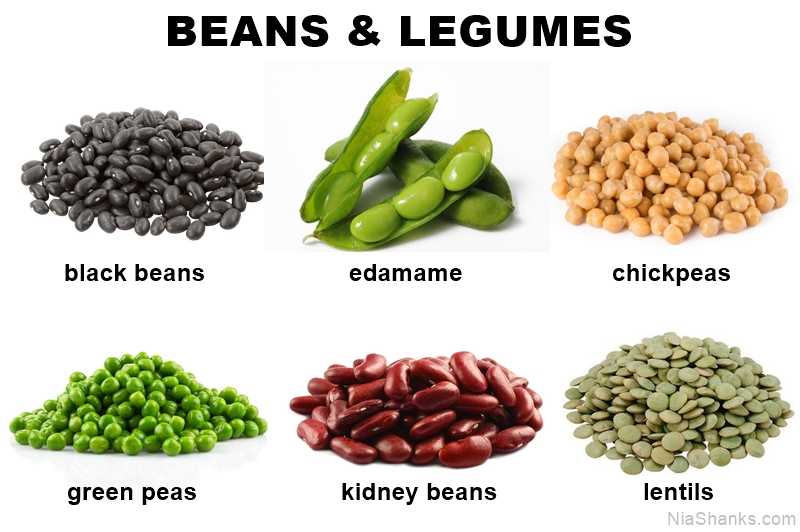 Tasty protein and fiber combined in a cheap package, especially if you buy dried beans and prepare them yourself. If you don’t eat meat, or much of it, this will be one of your main sources of protein. Even if you do eat meat, include these tasty foods.
Tasty protein and fiber combined in a cheap package, especially if you buy dried beans and prepare them yourself. If you don’t eat meat, or much of it, this will be one of your main sources of protein. Even if you do eat meat, include these tasty foods.
Whole Grains
 This category also includes foods like whole wheat pasta and breads.
This category also includes foods like whole wheat pasta and breads.
Why is white rice shown instead of brown rice — I thought brown rice was “less processed” and therefore healthier, you may be wondering. There’s not much nutritional difference between white and brown rice beyond fiber (which favors brown rice), so let your taste decide. Some people find white rice easier to digest than brown rice. In the end, choosing between them is a minute detail not worth obsessing over.
Herbs and Spices
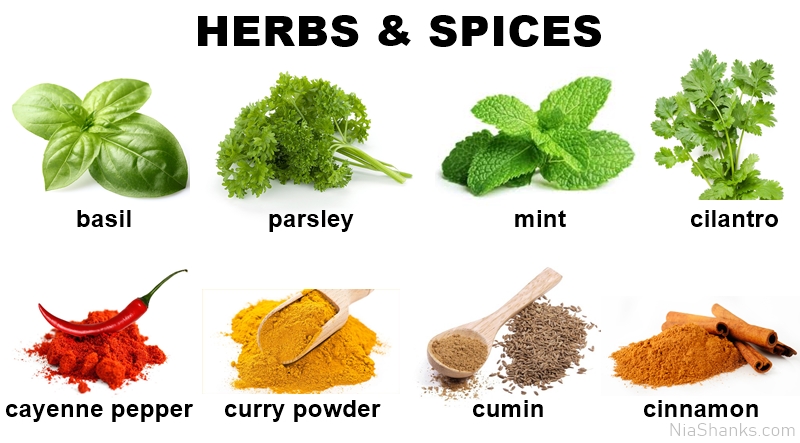 If you don’t use herbs and spices with your cooking, start. I’ve cooked countless meals that were bland and boring, but the right blend of spices made these meals delightfully craveable. Find recipes that use herbs and spices if you’re not a creative cook. They can make the difference between a meal you feel like you have to choke down and one that creates a symphony of flavors on your tastebuds.
If you don’t use herbs and spices with your cooking, start. I’ve cooked countless meals that were bland and boring, but the right blend of spices made these meals delightfully craveable. Find recipes that use herbs and spices if you’re not a creative cook. They can make the difference between a meal you feel like you have to choke down and one that creates a symphony of flavors on your tastebuds.
Fruits
 Choose from fresh or frozen. Canned fruits are okay if they’re packed in water and don’t have added sugar. Buy what’s in season or on sale to save money. Keep apples and other easy-to-grab fruits nearby if you tend to snack frequently.
Choose from fresh or frozen. Canned fruits are okay if they’re packed in water and don’t have added sugar. Buy what’s in season or on sale to save money. Keep apples and other easy-to-grab fruits nearby if you tend to snack frequently.
Recommended Article: The Chocolate Protein Shake That Actually Tastes Like a Milkshake
Calorie-Free Beverages
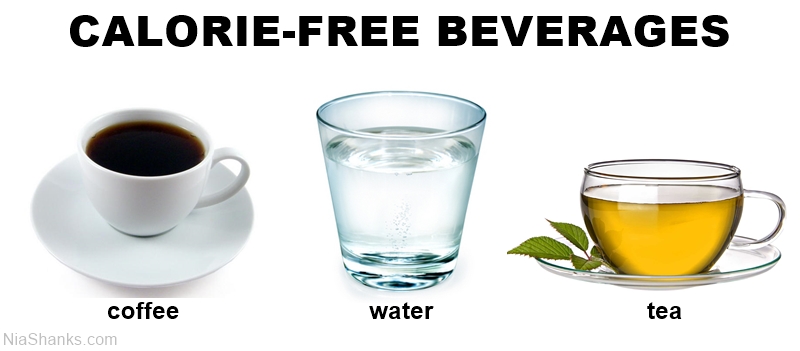 Sparkling water is another option and the carbonation can help curb appetite. Calorie-free soft drinks are okay in moderation and can help satisfy your sweet tooth. One of the simplest changes worth making is swapping calorie-laden beverages for their calorie-free or low-calorie equivalent.
Sparkling water is another option and the carbonation can help curb appetite. Calorie-free soft drinks are okay in moderation and can help satisfy your sweet tooth. One of the simplest changes worth making is swapping calorie-laden beverages for their calorie-free or low-calorie equivalent.
If you can only drink coffee with cream and sugar, that’s fine. You don’t have to force yourself to drink black coffee. This can only become something that might need to be kept in check if you use a lot of cream and sugar, or drink multiple cups of coffee throughout the day (then those spoonfuls of sugar and cream add up).
Want a low-calorie way to flavor your coffee? Mix a sugar-free hot cocoa packet (they’re only 25 calories) in your coffee. Makes a tasty low-calorie mocha.
What is “Most of The Time”?
The above food categories fall under the umbrella of foods to eat most of the time, meaning they should make up at least 80% of your food choices; this can be a daily or weekly average. The following image shows the percentage of whole and “fun” foods (covered next) consumed each day over the course of a week — the whole-foods average is 81%.
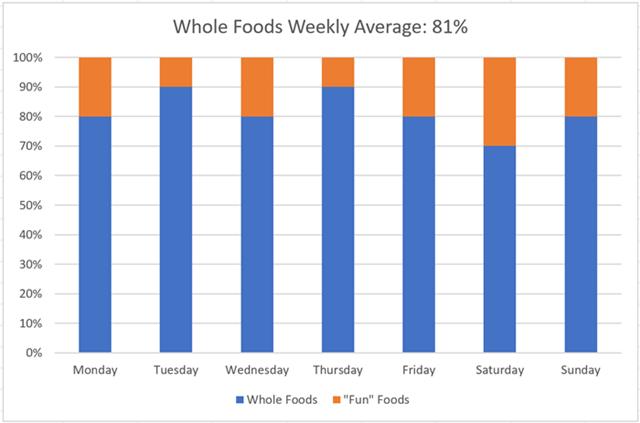 The tremendous benefit of aiming for at least an 80% average of whole foods is the flexibility it provides. Remember, this is a flexible lifestyle, not a perfection-obsessed diet. You can socialize and enjoy your favorite foods without feeling deprived or like you’re “on a diet.”
The tremendous benefit of aiming for at least an 80% average of whole foods is the flexibility it provides. Remember, this is a flexible lifestyle, not a perfection-obsessed diet. You can socialize and enjoy your favorite foods without feeling deprived or like you’re “on a diet.”
Eat These Foods Less Often
You know what to eat at least 80% of the time, so let’s go over the foods that can make up the remaining 0-20% depending on your needs and preferences.
But first, notice what is not being said. These foods are not bad, evil, forbidden, dirty, off limits, or guilty pleasures. Eating them does not make you bad, ugly, shameful, disgusting, a failure or anything else someone who wrote a diet book that bans these foods may have said you’d be if you enjoy them. Nor will eating these foods occasionally in reasonable amounts miraculously cause you to gain body fat. Only eating more than your body uses for a prolonged period causes the accumulation of body fat, and this can come from eating an excess of anything.
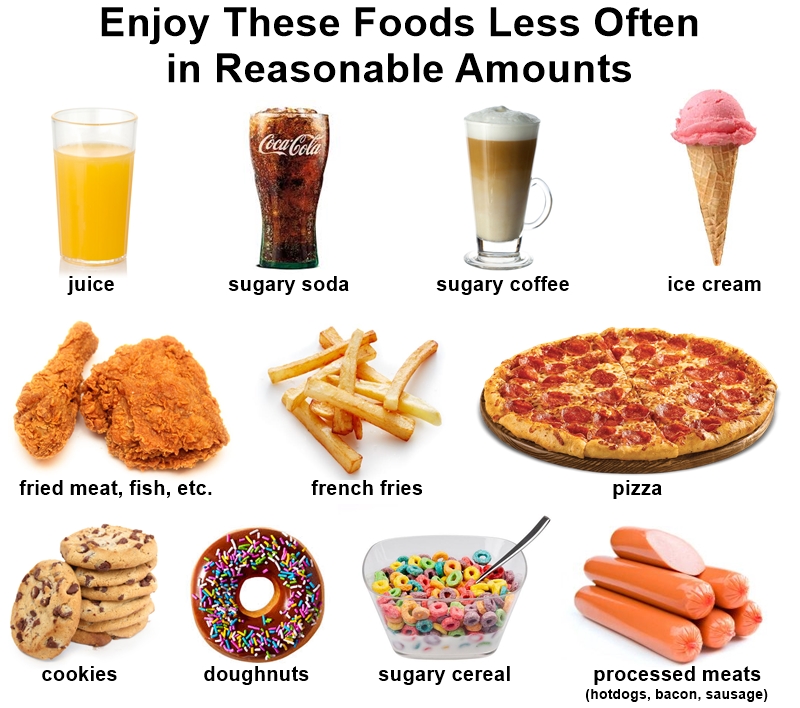
Eating healthy is complicated.
Not really. Eating healthy seems complicated because of the abundance of information on food, weight loss, disease prevention and what you should and shouldn’t eat to look better naked. It’s no wonder people are frustrated and discouraged because they’ve tried popular diets that promised to be the diet for effortless fat loss: low fat, low carb, vegetarian, intermittent fasting, ketogenic, and all the rest.
The Basics are Not Replaceable
It’s not uncommon for someone to read the information below and scoff that it’s “too simple.” They want more than the basics. They think a diet that emulates their favorite Instagram fit-pro’s habits will yield better results. They think they’re above the basics.
The problem, however, is that most people have not even mastered the basics. Complex, restrictive diets that eliminate foods or food groups don’t produce better, lasting results — they just reduce calorie intake. People falsely think they’re more effective because of their complexity. These unnecessarily obsessive, restrictive diets can lead to things you don’t want like binge eating, negative body image, or incessant yo-yo dieting.
Complex or complicated does not mean better. Don’t delude yourself into thinking you need something more advanced if you don’t apply the information shared here for months at a time.
Do You Want a Diet or a Lifestyle?
Most diets have a timeframe. You follow it for 12-16 weeks (or until your willpower bleeds dry) and then you’re done and go back to eating whatever was normal pre-diet, or worse because you can’t stop eating all the stuff that was banned from the diet. Sound familiar?
Someone who will stand on stage in a bikini to be judged will follow a diet that meticulously tracks calories to reach ultra-low levels of body fat that’s meant to be sustained for a short period of time (people often forget this part and think it’s easy, or healthy, to have very low body fat levels long term). Problems arise when the average person who just wants to feel great and look better naked attempts to mimic those diets.
Most people need to create a sustainable lifestyle built upon simple habits that can be maintained long term. Not for 12-16 weeks, but for 12-16 months and beyond. A major distinction between a diet and lifestyle: quick-fix diets instill a perfection mindset (never missing a meal, hitting the exact calorie target every day, never “cheating,” you go all in); a healthy-eating lifestyle is about consistency, not perfection, so there’s no burden or stress of thinking you need to be perfect day in, day out — it is not an “all or nothing” game.
Rigid diets that create a perfection-obsessed mindset around food can drown you in their monstrous wake of negative body image and disordered eating habits.
You Must Find Pleasure in the Process
You can only force yourself to follow a style of eating you hate, or that dominates your life, for so long. Eventually you’ll say Screw it! and throw your hands in the air as a declaration of frustration and signaling the end of the diet’s lifespan.
Many people mistakenly look at eating healthy as being torturous, bland, boring, difficult. Establishing better eating habits may be difficult in the beginning, depending on your current food habits, but you must focus on the pleasure that accompanies the process. The pleasure of nourishing your body; properly fueling and recovering from workouts; forging new habits that serve you; actively investing in your health; proving to yourself you can establish rewarding, positive habits.
If you get frustrated from trying to find vegetables or lean-protein sources you enjoy, or have trouble hitting the 80% whole-food target discussed below, refocus on the pleasures you should be reaping from this lifestyle change.
Does It Have to be about Fat Loss?
Tips for weight loss are laced throughout this article, because many people want to lose fat. If you’re burned out on constantly thinking about fat loss, watching what you eat, or otherwise being on a never-ending journey of trying to whittle down to a smaller size, don’t think about fat loss.
If your brain is begging for a break from basing every food choice on losing body fat, choose other reasons for changing your eating habits. Choose to adjust your eating choices to:
- Improve overall health (physical and mental)
- Increase energy levels
- Improve sleep quality
- Fuel and recover from workouts
- Slow down the aging process
- Contribute to self-care
- Increase physical strength and build muscle
How to Eat Healthy
Whatever your why may be for wanting to eat healthy, here are the foods that should make up most of your eating choices.
Eat These Foods Most of The Time
The common thread connecting these foods — they’re minimally processed whole foods. Why have these foods been chosen? Because eating mostly nutrient-dense whole foods, including lots of plant-based foods, has been shown to be most important for improving health and warding off disease.
The following images and examples are not exhaustive, and many could fall in other categories. Eggs, for example, could be listed in the fat and protein groups but appear under fats; corn is a grain when eaten as popcorn but considered a starchy vegetable when consumed as corn on the cob. Don’t get obsessed with minor details but use this as a guide for building meals and snacks.
Fats

Protein

Starchy Vegetables

Non-Starchy Vegetables

Bake them, sauté them, grill them, steam them, eat them raw, turn them into noodles and use in place of traditional pasta, blend them in smoothies. Doesn’t matter how you get them in your belly, just eat them.
Beans and Legumes

Whole Grains

Why is white rice shown instead of brown rice — I thought brown rice was “less processed” and therefore healthier, you may be wondering. There’s not much nutritional difference between white and brown rice beyond fiber (which favors brown rice), so let your taste decide. Some people find white rice easier to digest than brown rice. In the end, choosing between them is a minute detail not worth obsessing over.
Herbs and Spices

Fruits

Recommended Article: The Chocolate Protein Shake That Actually Tastes Like a Milkshake
Calorie-Free Beverages

If you can only drink coffee with cream and sugar, that’s fine. You don’t have to force yourself to drink black coffee. This can only become something that might need to be kept in check if you use a lot of cream and sugar, or drink multiple cups of coffee throughout the day (then those spoonfuls of sugar and cream add up).
Want a low-calorie way to flavor your coffee? Mix a sugar-free hot cocoa packet (they’re only 25 calories) in your coffee. Makes a tasty low-calorie mocha.
What is “Most of The Time”?
The above food categories fall under the umbrella of foods to eat most of the time, meaning they should make up at least 80% of your food choices; this can be a daily or weekly average. The following image shows the percentage of whole and “fun” foods (covered next) consumed each day over the course of a week — the whole-foods average is 81%.

Eat These Foods Less Often
You know what to eat at least 80% of the time, so let’s go over the foods that can make up the remaining 0-20% depending on your needs and preferences.
But first, notice what is not being said. These foods are not bad, evil, forbidden, dirty, off limits, or guilty pleasures. Eating them does not make you bad, ugly, shameful, disgusting, a failure or anything else someone who wrote a diet book that bans these foods may have said you’d be if you enjoy them. Nor will eating these foods occasionally in reasonable amounts miraculously cause you to gain body fat. Only eating more than your body uses for a prolonged period causes the accumulation of body fat, and this can come from eating an excess of anything.

Last edited:









